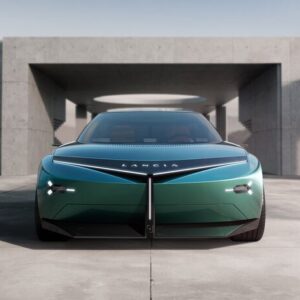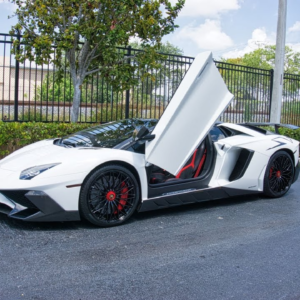From the July/August 2023 issue of Car and Driver.
60 mph: 4.3 sec1/4-Mile: 13.1 sec @ 104 mphBraking 70–0 mph: 182 ftRoadholding, 300-ft Skidpad: 0.86 gHighway Range: 270 mi
Here we are again. After gathering the year’s new EV offerings for a week of intense back-to-back scrutiny, rigorous driving, and long hours of charging, a Hyundai has come out on top. Following last year’s win by the Ioniq 5, that model’s new sedan sibling, the Ioniq 6, motors away with the top prize this year. Add strong showings by the Genesis Electrified GV70 and the Kia EV6 GT, and a picture starts to form: When it comes to EVs playing in the broad main swath of the market, the Hyundai-Kia-Genesis group is clearly out in front.
That the Ioniq 6 shares much with the Ioniq 5 is to its benefit, but the new entry does more than just put a three-box hat on the same platform and up the model name by one. “Just look at it,” we said of the Ioniq 5 when it won, and we could do the same for the Ioniq 6.
While the two siblings’ designs are dissimilar, the banana-shaped sedan is every bit as striking as the angular hatchback. We see a bit of the first-gen Mercedes CLS in the sloping profile. Hyundai claims the 1930s Stout Scarab as inspiration—and though that obscure machine and the Ioniq 6 are nearly a century apart, once you see pictures of the two, you know the notion isn’t just something the designers made up.
Regardless of whether the shape came to Hyundai designers by way of a turn-of-the-millennium four-door “coupe,” a Streamline Moderne–era proto-minivan, or some kind of fever dream, its aerodynamics give the Ioniq 6 a slip-through-the-air drag coefficient as low as 0.22. We also like it because it’s good to see an automaker introduce a dedicated EV that’s a sedan (the Polestar 2 and Tesla Model 3 are two others) rather than another mid-size crossover.
Underneath, Hyundai’s E-GMP platform continues to shine. This car comes with a single rear-mounted motor making 149 or 225 horsepower (depending on battery size) and 258 pound-feet of torque or can be had with dual motors that combine for 320 horses and 446 pound-feet. Most versions get a 77.4-kWh battery pack. Our EV of the Year test car, a dual-motor Limited, managed 220 miles in our highway test and is EPA rated at 270 miles of range.
Range projections get even better from there. The single-motor Limited nabs a 305-mile EPA estimate, the dual-motor SE with 18-inch wheels rather than the fancier trims’ 20s is good for 316 miles, and the single-motor SE caused jaws to drop earlier this year when Hyundai revealed its 361-mile EPA range estimate (though we observed only 260 miles in our highway test). That version also nets a 140-MPGe combined figure, topping the rear-drive Tesla Model 3’s 132 MPGe. (An entry-level model with a smaller 53.0-kWh battery pack delivers commensurately less range: 240 miles on the EPA cycle.)
When the electrons run low, the Ioniq 6’s 800-volt architecture allows for recharging at up to 235 kilowatts, making for some of the quickest charge times we’ve seen from any mainstream EV.
On the subject of speed, the dual-motor version gets to 60 mph in a brisk 4.3 seconds, although the accelerator mapping makes it feel less sporty than some other dual-motor EVs (the EV6 GT, for one). The same run in the 225-hp single-motor version takes 6.2 seconds. The Ioniq 6’s solid structure is imperturbable, lending the car genuine composure over lumpy pavement on the most challenging sections of our test loop. The ride is taut and well damped, and the car stays flat and secure during cornering. Hyundai has also mastered the “whoa,” with good brake-pedal feel and easy customization of lift-off regen via steering-wheel paddles, including the option of none at all.
We can’t say that Hyundai has mastered the EV soundtrack—although to be fair, no one has. Granted, this area is one of personal preference, and you certainly have your choice of spacey accompaniment, but we were happy to silence the noisemaker. Doing so allows the Ioniq 6 to show off its sound isolation.
Don’t expect upscale cabin materials at this price, although the design is inventive, particularly the sleek door panels. And the sloping roofline cuts into rear headroom even with the low-set seat cushion. Happily, Hyundai didn’t reinvent its infotainment system for electrified duty, and the switchgear isn’t different for different’s sake. Generous console storage further enhances livability. The trunk, though, is just as small as you’d guess. And the frunk isn’t much compensation—that space will hold little more than a few notebooks.
The Ioniq 6 is both a well-executed electric and a car we want to drive. This polished EV makes few missteps as it puts Hyundai’s E-GMP platform in the winner’s circle. Again.

Joe Lorio
Deputy Editor, Reviews and Features
Joe Lorio has been obsessed with cars since his Matchbox days, and he got his first subscription to Car and Driver at age 11. Joe started his career at Automobile Magazine under David E. Davis Jr., and his work has also appeared on websites including Amazon Autos, Autoblog, AutoTrader, Hagerty, Hemmings, KBB, and TrueCar.
 John Roe |Car and Driver
John Roe |Car and Driver

 View Photos
View Photos





